“For Realist painters at mid-century, the experience of the senses was not something to be allegorized. It was something to be given to the viewer full-on. Such a statement became a philosophical position. It was part of the materialist view of the world and by materialism, I mean the philosophical variety. Materialism is the opposite of spiritualism. Materialism as in the world is composed of matter. Manet’s striking stance against idealization, against metaphysics, places him in line politically with proponents of science, empiricism and progressive politics”….

Manet. Isabelle Lemonnier with a Muff. "We can see that in the distance between the watercolor sketches in the letters and the face of the DMA portrait. Lemonnier's arched brow, the upturned corners of her mouth, her gaze in our direction can all be seen as pleasant and engaging. At the same time, a slight air of detachment remains. Manet is often at pains as a painter to prohibit one reading from becoming dominant or stable. George Moore displays a relaxed, informality but also an alacrity. This is no accident or product of a lack of finish or resolution. It is a deliberate technique on Manet's part as definite as his addition of extra figures in the spaces of his crowded cafe scenes. His play between definition and an undoing of definitiveness where an opening up of the picture to different readings lies at the heart of the experience of modernity, he wants to offer his viewers."
When Renoir painted a woman, he made love to her with every stroke of the brush. Degas, under the guise of capturing a momentary and casual aspect of his model, could use his brush as a sort of psychological scalpel that probed and bared the subject’s inner self. Edouard Manet painted in neither of these ways. He was a responsive to feminine attraction as was Renoir, but he did not approve of making love in public, and even his nudes are shown to us with no statement of his response to them and no effort to suggest or stimulate a response in us.
“In contrast to Victorine Meurent who dons the outfit of a male bullfighter and also poses nude for Manet, Berthe Morisot being an
unmarried woman of Manet’s class and social circle would never have taken off her clothes for a painting. At the same time I have argued in Manet and the Family Romance that Manet’s paintings of her are a highly experimental, that their relationship was such that Manet could take artistic liberties with the works even if certain notions of propriety had to be upheld.Hermother chaperoned the sittings…. It seems the term femme fatale has been circulated among the curious.” Berthe Morisot with a Fan goes so far as to block Morisot’s face with the fan and not coyly or seductively as some genre painters of Manet’s day might have suggested.” ( Nancy Locke )
Manet did not have Degas’s passion for analyzing character , but he was certainly aware of complications and subtleties in the natures of people he knew well and painted frequently- for instance Berthe Morisot. Yet he never probed; it is as if he would have considered it at least a discourtesy, even if not an invasion of privacy, to put on record anything more than the appearance his subjects chose to present to society.
But in this tactful objectivity there is no coldness. We see Manet’s interested response reflected back to us from every face he paints. More often than not the eyes look directly into ours. Typically, the glance is noncommittal but alert, sometimes almost questioning but always a little guarded. We know a great deal about the character of Manet’s people, but what we know is the result of spontaneous deductions that are inevitable when we face the brilliant presences Manet materializes for us.
Even in a most exceptional case like the portrait of George Moore, which is a devastating revelation of a sensitive and intelligent, but rather effete and watery young man, Manet has not interpreted a character so much as he has summarized the salient aspects of an appearance that was an unusually open statement of the person who lived behind it. There is never any feeling that Manet is unperceptive; there is always the feeling that the artist observes the model and the model observes the artist, whatever they think of one another may legitimately be sensed but, out of mutual courtesy, must remain undeclared.
…”These reflections all contain an element of biography. That is, I am drawing on knowledge we have through documentation of Rembrandt’s relationship with Hendrickje Stoffels and Manet with Suzanne Leenhoff and Berthe Morisot. Biography here becomes part of the contex
at we need to investigate in order to understand the parameters of the representation.Rembrandt could not have achieved the psychological complexity and the intimacy he imparts to his Bathsheba with a model he hired the day of the first sitting. Hendrickje’s pregnancy and her precarious social status have distinct parallels with Bathsheba’s, although in the Old Testament it is David who is rebuked by the Prophet Nathan and the offspring of their adulterous union who is stricken with the fetal illness. Regardless, however, of any of these relationships for what we might imagine to have been Rembrandt’s or Manet’s desires for any of these models, I want to pause before leaving you with the impression that the
linchpin of these works somehow lies in the realm of the artist’s desire.” …
“Berthe Morisot with a Muff” shows us a young lady elegantly attired in a fur coat and stylish bonnet, wisps of dark hair falling seductively over her forehead and ear. This is not a primped fashion plate, but rather an intensely feminine figure who looks tentatively toward the painter. After 1870 her eyes look straight at him- talking, as in “Berthe Morisot with a Fan” .
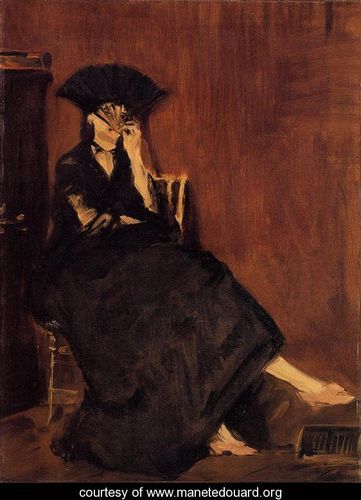
Berthe Morisot With a Fan. :Over a seven year period (1868-74), Manet painted eleven portraits of Berthe Morisot, making her his most frequent model. His wife is in only five paintings and Victorine Meurent, eight. Manet produced his final images of Morisot during the time she became involved with his younger brother and then married him (1872-74). These last portraits provide a window into the intense desire and rivalry which Manet felt in his relationship with her. As the loss of Morisot neared, there was an increasing distortion of her image and departure from his usual painterly technique. This culminates in the skull-like portrait: Berthe Morisot in a mourning hat, 1874.* After Morisot's marriage, Manet never painted her again. At his death, seven of her eleven portraits remained in his private collection.---
What could be a more eloquent tribute? If Matisse was right when he said that Manet was “the first painter to have translated his sensations immediately” , then this little painting, scarcely larger than a piece of stationary- can be regarded as the immediate translation of Manet’s feeling for this exceptional woman. Paul Valéry writing about “Bouquet of Violets” , calls it a “poem” that combines “the solidity of his art with mystery… firmly stating the distinctive and the essential charm of Berthe Morisot”. It is a harmony of blacks- black hat, black cape, black ribbons, black silk, black wool, dark eyes- all against the pale shades of highlighted skin, wisps of chestnut hair, and the nacre tones of the background.

Berthe Morisot with a Bouquet of Violets. 1872. Berthe Morisot's letters verify what one already knows from her paintings- that she was an enchantingly feminine creature. Everything indicates that she was more than half in love with Manet, with whom she studied informally, but she finally settled for marriage with his brother. Manet painted her many times, but more often as a model whose vividly defined features were made to order for him than as an individual for whom he certainly felt affection. Although it has the same vivacious life, this portrait of Berthe is no more intimate or indicative of a deeper empathy and complicity that other work of his.
Ann Higonnet: “She( Morisot ) was responsive to masculine attention to the point of gullibility, as she admitted herself… reproachful when a suitor’s ardor cooled, as in the case of Puvis de Chavannes; jealous when another woman, Eva Gonzales, younger and a painter to boot, elicited Manet’s enthusiasm. Even her periods of anorexia point to the repression of a vital and personal side of her. It would be stretching credibility to believe that a woman nearing thirty, still unattached and as hungry as Morisot was for admirers, would have remained strictly professional under such circumstances.”
…Nancy Locke:Michel Foucault questions the emphasis we often give to desire as the great secret of the individual. He does not think desire is the source of sexuality that has to be liberated. He said in an interview that it is very interesting to note that for centuries, people generally, as well as doctors, psychiatrists. And even liberation movements have always spoken about desire and never about pleasure. We have to liberate our desire they say. No we have to create new pleasure and then maybe desire will follow.
What is that stake in this shift of emphasis from desire to pleasure? What do we stand to gain from this stance in our art history? Well many things. For one we would not want account of Manet’s portraits of certain individuals, whether a wife, paid model, or subject of flirtatious attention, to turn on whether in the end a certain kind of relationship took place. I think we can agree that that is completely beside the point of our analysis of a painting. It is inaccessible to us and as Foucault argues it is all too easy for an account of desire to be medicalized, moralized, judged to be normal, abnormal, permissible, or not and the like.
In the final analysis it is of no great importance whether Manet and Morisot ever became lovers. It is assumed that painters put on canvas only what they see. But the human eye is infinitely more than a lens in a black box; there is also the “mind’s eye” , which continues to see long after the object has disappeared and which translates images into mental processes. For Manet, Morisot was manifestly the inspiration for his most sensitive, most sensual, most unforgettable portraits. ” What is pure art in the modern conception?” , Baudelaire asked. “It is to create a suggestive magic containing at the same time the object and the subject, the world outside the artist and the artist himself.”
This, Manet did sublimely in his portraits of Morisot. She was also the person who probably understood him and his artistic aspirations better than any other, and the one to whom he may have revealed more of himself than to any other. For Morisot, Manet was a mentor, a mirror, a model, a man she loved to the end of his life and possibly to the end of her own. One may even wonder how much her attachment to him entered into her decision to marry his feckless brother Eugene, who looked remarkably like Edouard; and the same initials. For the rest of her life she was Mme E. Manet- a detail she could not have overlooked, for that was how she signed her formal letters- and for the rest of Edouard’s she could see him in his studio, or in hers, without causing raised eyebrows. As the wife of any other man, she would have found that close to impossible.
Michel Foucault’s interest in pleasure is linked with an interest in tearing down rigid categories of identity in preventing personal identity from becoming the law, the principle, the rule of individual existence as David Halperin as written. “Unlike desire, which expresses the subject’s individuality, history, and identity as a subject, pleasure is desubjectivating, impersonal. It shatters identity, subjectivity, and dissolves the subject, however fleetingly, into the sensorial continuum of the body, into the unconscious dreaming of the mind,” that was David Halperin.
ADDENDUM:
“How does Foucault’s notion of pleasure square with Manet’s approach to painting? Very closely and intricately I would say. Let’s take Manet’s Cafe Concert as an example. This is a painting from 1878 now in the Walters Art Gallery, Baltimore The Walters painting in many ways emblematizes Manet’s work from the 1870s. The Cafe Concert, essentially an upscale cafe with live entertainment and often a cover charge, appears as a densely populated space. The central figure, this man of the world with his crisp collar—cravat–and elegant hat, his hand leaning diffidently on his walking stick. This man turns to look presumably towards the stage, towards the singer whose silvery reflection we see in the mirror. Behind him a waitress quaffs a mug as she surveys the room. Waitresses at Cafe Concert were asked to drink glasses of colored liquid as a way of encouraging consumption of drinks.
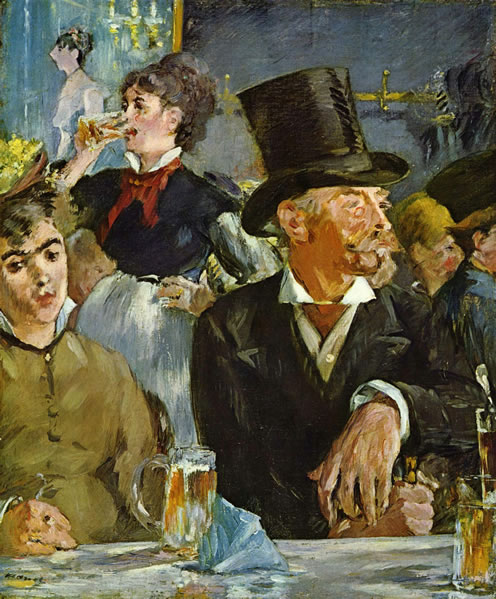
Locke:almost a double figure there. So is she peering out toward us or toward the stage? Manet seems to thrive on these kinds of ambiguities, space opening on to peering eyes, hat next to blond bun....
Next to him is a woman who appears down on her luck. She has hardly touched her drink and her downcast eyes, lack of interest in the performance, and cigarette suggests a woman who may not be able to make ends meet, as many working women in the 19th century could not, who perhaps dabbles in clandestine prostitution. She may well be allowing the prosperous man to buy her more than a drink in exchange for the evening that lies ahead.
Manet does not stop with his studies of the contrasting moral universes of these main figures. He gives us another figure with blue smock at the bar. This man, here is the smock and here is his hat and his face is completely cut off by the side of the canvas, as well as a woman here her blond hair in a kind of beehive glimpse to the right of the man. Her smudged makeup seems a very late addition to the painting, something Manet couldn’t resist adding to this space between the figures.
There is even another women, we can glimpse behind the waitress’ apron, right here and this is a little hard to see, but I think if you look a little bit and use your imagination, it is so summarily painted, you can either see, this is an eye, eye socket, eyebrow with her other eye being here, in other words she is either looking towards the stage like the man, and this is of course for her hat and her whole head facing this direction.
I think it’s also possible to see her face as much closer to us and outlined like this. So with a hat that comes more to the front of her head, this green, and so this becomes her left eye. So I think you can see almost a double figure there. So is she peering out toward us or toward the stage? Manet seems to thrive on these kinds of ambiguities, space opening on to peering eyes, hat next to blond bun.


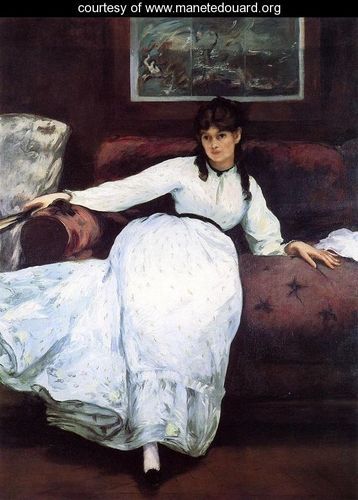
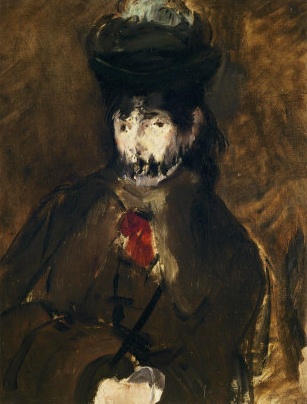
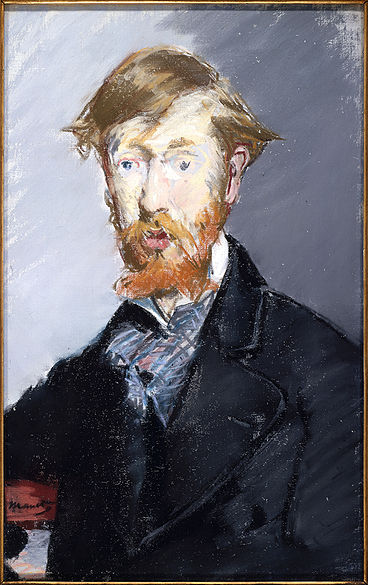

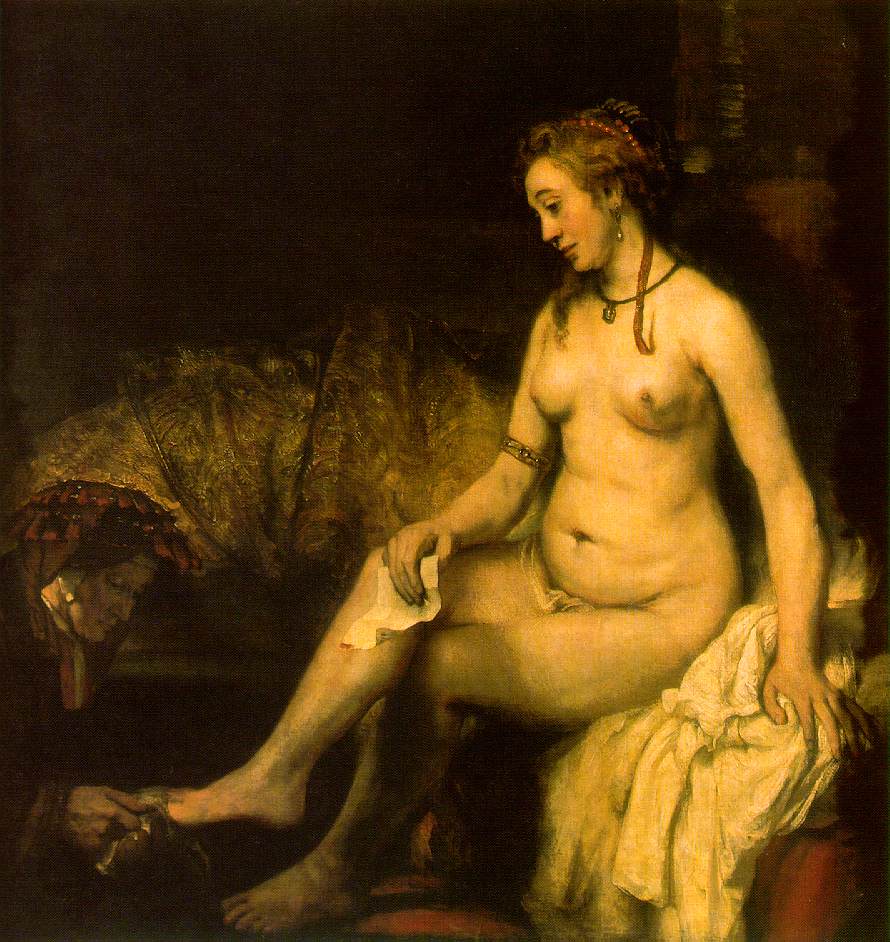
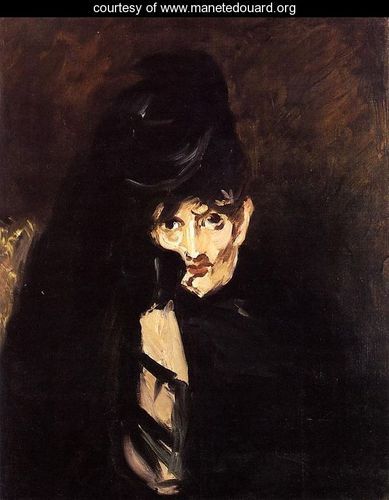
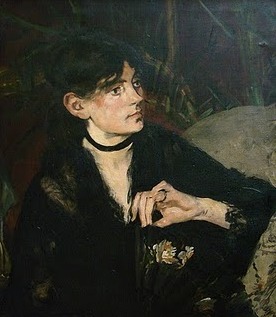



 COMMENTS
COMMENTS
Manet v Morisot fascinating, eloquent, astute and informative. Gilded my pale understanding of Manet.
Not alone, you barely note the ‘fleeting star’ (who, having taken so much of his time in life, would not even allow the Master’s widow and sister-in-law to grieve in peace.)
May I ask who/what you see in Eva Gonzales’ oil-sketch recently Certified ‘self-portrait’. Cross reference with another, finely resolved oil on canvas, evidently *Eva by Eva, suggests it is not a caption of Eva, and there is more to the sketch than ‘meets the eye’.
I wonder also what/who you make of ‘Lady in Fur’ 1880 Belvedere Vienna.
The ‘spade-shaped’ chin is accentuated with a cluster of .. ‘unsightly’ warts, On opposite side, 1cm below lip extreme- she has a ‘fairy kiss’. This is consistently included in his first painting, the ‘lilac’ pastel 1879, in Jeanne’s exquisite pencil drawing and in a crisp, hi-res photo. Including ‘Lady in Fur’ and (defying vanity) the beautiful pink, brown and blue (& bands of harlequin textures, but no trace of purple, lilac or indigo) ‘Mille Vue_’ there are 7 precisely depicted examples of the sometimes unnoticed ‘fairy kiss’.
If it may be of interest, have a short re-view of both the oil-sketch, which, seen in perspective must rate among Eva’s greatest works, and the unidentified ‘siren’ in Fur. Be happy to fwd via email.
Best wishes, James Gorin
will take a look at this next week and come up with a response. thx. for reading.
d: